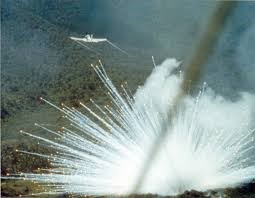
White phosphorus bomb

13.10.2023
white phosphorus bomb , Daily Current Affairs , RACE IAS : Best IAS Coaching in Lucknow
Why in the news?
Recently the Israeli army has been accused of using white phosphorus bombs on the civilian population of Gaza.
About White Phosphorus Bomb:
- White phosphorus bomb is prepared by mixing white phosphorus and rubber.
- Phosphorus is a wax-like chemical, which is pale yellow or colorless and has a strong odor like rotten garlic.
- It is a highly flammable chemical that starts burning rapidly as soon as it comes in contact with air.
- It is used by armies around the world in incendiary weapons for a variety of purposes, such as illuminating targets at night or inflicting damage on enemies.
- Once ignited, the substance is very difficult to put out, as it sticks to many surfaces, including skin and clothing.
- Since it is a wax-like substance, it is very difficult to remove and often starts to burn again as soon as the bandages are removed.
- White phosphorus munitions are not banned under international law, but because of their incendiary effects, their use must be strictly regulated.
Temperature of white phosphorus bomb:
- It burns at a temperature of 800 °C and spontaneously ignites up to 1,300 °C when exposed to oxygen, and produces white, dense smoke, which is used by armies to create smokescreens in sensitive areas. Is.
- White phosphorus can cause rapidly spreading and widespread fires on the ground.
How dangerous is the white phosphorus bomb:
- Since phosphorus bombs can burn up to 1300 degrees Celsius, it is more burning and dangerous than fire.
- Wherever this bomb is dropped, it rapidly absorbs all the oxygen of that place.
- In such a situation, those who do not get burnt by its fire, they die due to suffocation.
- It continues to burn until it is completely destroyed.
- Even if water is poured on it, it does not extinguish easily, rather it flares up further creating a cloud of smoke.
Examples of use of white phosphorus bombs in wars:
- The British Army used it in the Second World War.
- Taking action against Islamic State (ISIS), the US Army also dropped phosphorus bombs on many areas of Syria and Iraq.
- Israel acknowledged that it had used phosphorus bombs in combat against Hezbollah during the 2006 Lebanon War.
What are incendiary weapons?
- They are weapons or ammunition designed to set fire to objects or to cause burns or respiratory injuries to people through the action of flame, heat, or a combination thereof, using a flammable substance such as napalm or white Resulting from the chemical reaction of phosphorus.
- In 1972, the United Nations General Assembly passed a resolution placing incendiary weapons in the "regarded category of weapons".
- The definition in Article 1 of Protocol III to the Convention on Certain Conventional Weapons excludes multipurpose weapons, particularly weapons containing white phosphorus.
- Because white phosphorus has legal uses, shells filled with it are not directly banned by international humanitarian law.
Ban on white phosphorus bomb:
- In view of the dangers of this bomb, white phosphorus was almost banned in the Geneva Convention in 1980.
- Its use was allowed only for certain reasons and places.
- In the protocol made under the Convention on Certain Conventional Weapons (CCW), 115 countries signed it, agreeing to its minimal use.
- Under CCW, if this bomb is used in residential areas, it will be considered a chemical attack, and action can also be taken against the attacking country under war crimes.